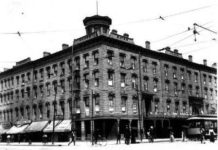
The Cleveland torso murders may have been the work of the first serial killer in United States history.
One day in September of 1935, in the Kingsbury Run area of Cleveland, Ohio, two bodies were found in the bushes. Police were called immediately and, after looking over the crime scene, were able to confidently state that there were two male bodies that had been emasculated and beheaded. There was no blood at the scene, leading detectives to conclude they had been killed elsewhere and transported to the crime site.
One of the bodies would remain unidentified, but the other was identified as an Edward Andrassy, who was known to the police as a petty criminal. Curiously, it was determined that the anonymous man had been killed several weeks before Andrassy.
Police work began in earnest and the workload increased when the body of a female showed up in January of 1936. She had been killed in a similar manner to the two men. Detectives were puzzled that the killer had changed the gender of his victims, which was unusual. The body was soon identified as Flo Polillo, a frequent patron of bars in the area.
At this point the famous Eliot Ness became involved, as he was Cleveland’s chief of Public Safety. He added himself to the growing number of law enforcement working on the case.
The murders continued. In June of 1936 a male body was found that featured several notable tattoos. Despite those distinctive markings, the body was never identified.
A partial body found in September had a hat nearby that was later identified as one given to a homeless man by a local woman. This reinforced the theory that the Cleveland torso murders were being committed solely on people from the lowest rungs of society.
There was a slight lull in the murders and, although the investigation continued at a frantic pace, Ness and the police were not any closer to finding the killer.
The killer apparently killed six more times before the last canoncial victim was found in August of 1938 (like Jack the Ripper, there was some disagreement among law enforcement as to the number of murders committed by the killer).
The hunt for murderer hit one dead end after another. Investigators were hopeful when a man was identified who often went to a bar patronized by several of the victims. This man was known to become angry and threatening when drunk. The man was taken into custody and, after some time, confessed to one murder. Unfortunately, he killed himself before he was fully questioned about the other murders. Suspiciously, after his death, he was found to have several broken ribs, which acquaintances of the man said he didn’t have when he went into police custody. This led the press and general populace to believe his confession was worthless and had been obtained under physical force.
Later, Ness himself oversaw the pursuit of another man, a doctor with a history of mental illness. He was brought in and failed a primative lie detector test. Ness felt he was finally on the path to the killer and continued to press the medical man. The doctor eluded Ness by voluntarily committing himself to a mental institution, which placed him out of reach of Ness and his team. Had Ness pursued the doctor further, the doctor had an insanity defense virtually locked in place.
Coincidentally, the Cleveland torso murders appeared to stop after the doctor went into that mental hospital. Cleveland police continued to investigate the crimes, but no convictions were ever made and the murders remain a cold case that may be solved in the future — or it may remain an unsolved puzzle from the realm of 20th century true crime.

![20131219-012432[1]](https://coolinterestingnews.com/wp-content/uploads/2013/12/20131219-0124321.jpg)












